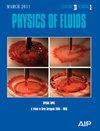Macroscopic and stable gas film obtained by superhydrophobic step and its drag reduction performance
IF 4.3
2区 工程技术
Q1 MECHANICS
引用次数: 0
Abstract
Drag reduction technology has a promising application in marine fields and has drawn much interest in scientific fields. Superhydrophobic surface has been proven to be effective in drag reduction due to thin film of gas adsorbed on surface because of its low friction drag and large slip length. Here, macroscopic and stable gas film was observed when water flowed over superhydrophobic surface with step without additional gas injection under laminar flow and turbulent flow. Superhydrophobic surface was prepared with contact angle more than 150° and roll-off angle nearly 0°. Macroscopic gas film could maintain under laminar flow and turbulent flow and keep up to 80% after 1 h water flowing with optimized parameters of step, showing different morphological deformations under different velocities and Reynolds numbers. Compared with untreated hydrophilic surface, superhydrophobic surface with step exhibited good drag reduction performance with maximum drag reduction rate 20% under laminar flow and turbulent flow, after optimizing of height of step and distance between steps. Mechanisms of gas film drag reduction were the ultra-low skin friction drag force between liquid–gas interface, large slip length on liquid–gas interface, and flexible gas film surface acted like compliant wall. Gas film of millimeter scale was much larger than thickness of boundary layer and reduced turbulence intensity near wall. This work provides a new way to obtain macroscopic gas film and analyze liquid–gas interface.通过超疏水步骤获得的宏观稳定气膜及其减阻性能
减阻技术在海洋领域有着广阔的应用前景,也引起了科学界的极大兴趣。超疏水表面因其摩擦阻力小、滑移长度大,表面吸附的气体薄膜已被证明能有效减少阻力。在这里,当水流过超疏水表面时,在层流和湍流条件下,在不额外注入气体的情况下,观察到了宏观稳定的气膜。超疏水表面的接触角大于 150°,滚动角接近 0°。宏观气膜在层流和湍流中都能保持,在优化阶梯参数的情况下,水流 1 小时后,宏观气膜的保持率高达 80%,在不同速度和雷诺数下呈现不同的形态变形。与未经处理的亲水表面相比,带阶梯的超疏水表面具有良好的减阻性能,在优化阶梯高度和阶梯间距后,层流和湍流下的最大减阻率均为 20%。气膜阻力降低的机理是液气界面之间超低的表皮摩擦阻力、液气界面上较大的滑移长度以及柔性气膜表面像顺应壁一样发挥作用。毫米尺度的气膜远大于边界层厚度,降低了壁附近的湍流强度。这项工作为获得宏观气膜和分析液气界面提供了一种新方法。
本文章由计算机程序翻译,如有差异,请以英文原文为准。
求助全文
约1分钟内获得全文
求助全文
来源期刊

Physics of Fluids
物理-力学
CiteScore
6.50
自引率
41.30%
发文量
2063
审稿时长
2.6 months
期刊介绍:
Physics of Fluids (PoF) is a preeminent journal devoted to publishing original theoretical, computational, and experimental contributions to the understanding of the dynamics of gases, liquids, and complex or multiphase fluids. Topics published in PoF are diverse and reflect the most important subjects in fluid dynamics, including, but not limited to:
-Acoustics
-Aerospace and aeronautical flow
-Astrophysical flow
-Biofluid mechanics
-Cavitation and cavitating flows
-Combustion flows
-Complex fluids
-Compressible flow
-Computational fluid dynamics
-Contact lines
-Continuum mechanics
-Convection
-Cryogenic flow
-Droplets
-Electrical and magnetic effects in fluid flow
-Foam, bubble, and film mechanics
-Flow control
-Flow instability and transition
-Flow orientation and anisotropy
-Flows with other transport phenomena
-Flows with complex boundary conditions
-Flow visualization
-Fluid mechanics
-Fluid physical properties
-Fluid–structure interactions
-Free surface flows
-Geophysical flow
-Interfacial flow
-Knudsen flow
-Laminar flow
-Liquid crystals
-Mathematics of fluids
-Micro- and nanofluid mechanics
-Mixing
-Molecular theory
-Nanofluidics
-Particulate, multiphase, and granular flow
-Processing flows
-Relativistic fluid mechanics
-Rotating flows
-Shock wave phenomena
-Soft matter
-Stratified flows
-Supercritical fluids
-Superfluidity
-Thermodynamics of flow systems
-Transonic flow
-Turbulent flow
-Viscous and non-Newtonian flow
-Viscoelasticity
-Vortex dynamics
-Waves
 求助内容:
求助内容: 应助结果提醒方式:
应助结果提醒方式:


